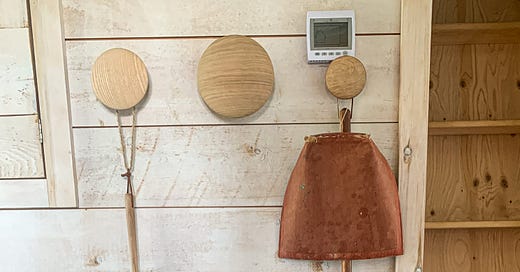I'm grateful for my broom
Gratitude is on my mind. I’ve been reading back issues of the New York Times’ Letter of Recommendation for my writing class, followed by an assignment to write my own. The column came about when staff writer Sam Anderson “figured there was no shortage of places to find out what writers hate but, outside of pop music criticism, there were vanishingly few spaces for writers to talk about what they love.” There are tributes to dental floss, filet-o-fish sandwiches, diaries, shopping at the dump and erotic thrillers, but I was stumped. Where does my list start? Where does it end?
The next day I found myself on my yoga mat, my legs folded beneath me, hands on my thighs, airpods in my ears, laptop on the floor. I’m following along with a class that begins with a ‘gratitude tornado,’ something I’ve never done before. The teacher says she’s from Northern California, where she grew up amongst hippies who forced her to practice gratitude. It was hard, she said, because she was always thinking about what she was not thankful for. Specific exercises, like the tornado, make it easier. She sets a timer for 60 seconds, acknowledges that it can be embarrassing, and begins saying out loud what she’s grateful for - her health. Her dog. Her espresso machine. Linen sheets. Moisturizer.
Clusters of white poplar tree fluff tumble by my yoga mat. Bits of last night’s tortilla chips sit under the table. Sand pools around the sandals at the door. And then, I hear my voice piercing the room - I am grateful for my broom.
Just above eye level on the white-washed wall to the left of the cottage door, there are three hooks. The hooks - smooth, flat wooden circles varying in diameter - are from Design Within Reach, left over from a job my sister worked on. They are a statement in themselves and should be treated as a form, not a function. But we make an exception for our wooden broom and its accompanying Japanese dust pan.
Most traditionally-crafted brooms are made from broom corn, a crop grown and harvested specifically for broom manufacturing. Once the stalks are dried, they are bundled together in tassels and wrapped with wire or cord. The end is cut evenly, and then a tool called a nipper is pulled over the straw like two fingers along an almost-empty tube of toothpaste. This process flattens the broom before its final stitching. This stitching can be intricate, like the smocking on a dress, or a simple straight line. Our broom sports the latter. It’s the dustpan that’s unique. Harimi dust pans are made from layers of sturdy Japanese washi paper painted with a traditional Bengara, a red earth pigment that’s resistant to sunlight, heat, and air. I like that the result is strong but thin as a piece of paper. A thick dust pan leaves remnants of dirt behind. Harimi leaves nothing.
I share the cottage with my sister, her husband, my husband, our three sons, her daughter and son. My other sisters and cousins share a cottage on the other side of the gully that borders the western edge of our cottage. The south side is a farmers field, and the north is a rocky bank heading down to the beach. There is a shower outside to rinse salt from skin and sand from feet, but sand, grass, hay, and cookie crumbs still make their way inside. A friend once called the cottage ‘sandy/scandi,’ a place that celebrates a simple Scandinavian vibe, but with a sprinkle of sand on the floors to keep everything from feeling too precious. I have to wear shoes inside; the truth exfoliates the bottom of my feet and reminds me, continuously, that it’s time to sweep.
The broom and dustpan were a house-guest gift. It was an unusual gift, given that most guests bring a case of beer or an armful of zucchini. I hadn’t used a wooden broom for years. The floors in our city home have old wooden floorboards with wide, uneven grooves between the planks. Brooms - modern or traditional - push dust and dirt into the grooves. A vacuum is the only effective form of dirt removal. But the floor at the cottage is made for a broom. It’s a smooth poured concrete with only a few seams – at the edge of the kitchen, halfway down the hallway, and at the entrances to bedrooms. The straw swipes across the floor with efficiency and grace. It’s a pale gray floor with a touch of tahini beige mottled throughout, hiding sand and sundry other things. The broom excavates it all with a gentle swish. It even rakes across the carpet beneath the coffee table where Pippa likes to sleep, pulling up satisfying tumbleweeds of her auburn hair and sand. Sweeping brushes away yesterday.
The broom is an object that can be used and enjoyed, but true enjoyment requires quiet. In full summer this cottage is a revolving door of teenagers in wet bathing suits with sand sprayed up their shins. I try to embody the casual aunt who breezes through the kitchen while the teenagers make toasted tomato and cucumber sandwiches for lunch. I don’t say, hey guys don’t forget to clean up after yourself, like I did last summer and the summer before. Who wants to be a drag? Instead I float around, watching as the last of the aged cheddar is sliced thickly and added to their sandwiches. I catch my breath when tomato juice drips off the counter and down the cupboard below. I turn away when they stuff crusts into the compost bin until coffee grounds spill onto the floor. I bite my fist and turn away. Soon they’ll be gone, soon they’ll be back at the beach, and I’ll be alone with the broom.




